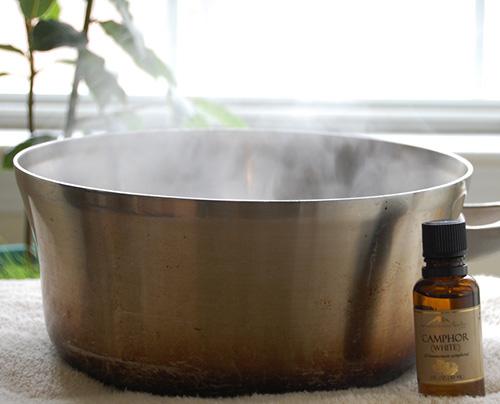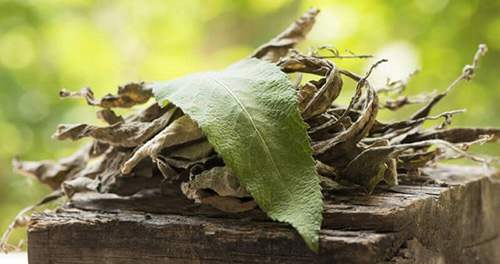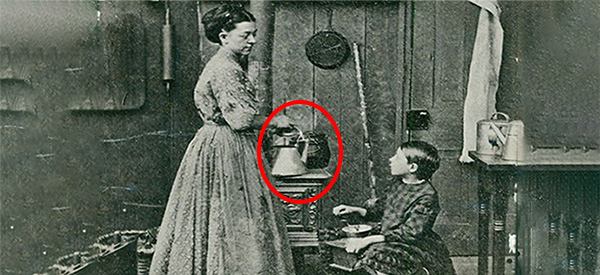Are you familiar with camphor and the healing properties of this essential oil?
Used since time immemorial for its healing and aromatic properties, the health benefits of camphor are not only well known but wide ranging; from being used as an expectorant, antiseptic and analgesic to having anti-bacterial, anti-fungal and insect-repelling properties. According to folklore, a lump of camphor was worn around the neck, in what were known as burlaps, to help protect against infection. Though its precise effects may not then have been fully understood, it’s use in modern medicine is firmly established; here we’ll look at how you can make use of it as a home remedy in the treatment of many ailments.
Where does camphor oil come from?: The white, waxy crystalline substance was traditionally obtained through a distillation process from the wood and branches of the fragrant evergreen Cinnamomum Camphora tree. Most natural camphor today however is distilled from the leaves in order to preserve the life of the tree. That said, since 1930, the majority of camphor on the market today is synthetically produced from turpentine oil. Though the Cinnamomum Camphora is native to China, Taiwan and Japan it has since been introduced to many countries including North America. 
Related: 10 Trees Every Survivalist Should Know and Why
Sacred use: Renowned for its pungent aromatic odour, the tree is identifiable by its distinct smell when its leaves are crushed. Valued as a sacred scent in early Christianity and Islam it is still used in Hindu pooja ceremonies today. The Persian Šāh-nāma text, speaks of how highly prized it was for it’s scent and confirms the use of kāpūr (Camphor) for embalming corpses during the Sasanian Empire, the last pre-Islam Persian empire.
Related: 26 Ancient Remedies That We Lost to History
Expectorant: Its firmly established use as an expectorant in modern medicine would explain why, according to folklore, our ancestors wore it round their necks. It is identified in the apothecary of Henry Hughes, who was born in 1825 and a pioneer in natural medicine, as being an effective chest rub when mixed with olive oil for the treatment of croup. Now approved by the FDA for such purposes, it is one of the main ingredients in Vick’s Vaporub. When a cream or ointment containing camphor is rubbed onto the body, camphor vapors are released as a result of body heat, which when inhaled help to loosen mucus and clear the lungs. It can also be inhaled through use of a steam vaporizer to help control coughs by producing a local anesthetic action to the throat.
Anti Bacterial: One study has shown camphor essential oil to have an anti-microbial effect on Streptococci bacteria, which can cause a range of infections which vary in severity from mild throat infections to life-threatening infections of the blood or organs. It was also found to inhibit Enterococcus faecalis, a bacteria which can sometimes cause intestinal problems. What’s more, a study in 2015 found camphecene a camphor derivative, to be effective in inhibiting influenza A and B viruses paving the way for further investigation of its use as a potential antiviral and further validating why our ancestors might have worn it to ward off illnesses.
Analgesic: Having been approved by the FDA for topical use as an analgesic and anesthetic in concentrations of 3% to 11% it is widely used as an ingredient in many topical products from treating pain related to cold sores, insect stings and bites to minor burns and hemorrhoids. Tiger balm for instance combines camphor with menthol both having the effect of triggering the skins cooling receptors and thus masking the underlying pain. Despite being used as an analgesic for centuries and studies confirming its effectiveness in desensitizing sensory nerves, its precise mechanism of action is not known. Studies do confirm however that it increases blood flow in both skin and muscle. From this we can draw the conclusion that it is beneficial for circulation.
Related: Similar to Morphine: The Best Natural Painkiller that Grows in Your Backyard
Insect repellent: Camphor can also used as an insect repellent and in particular is used to keep mosquitos at bay. It acts in a way similar to citronella by masking the smell of the carbon dioxide and chemicals produced by our body, which is what attracts mosquitos in the first place. To keep a room mosquito free, simply place a few tablets in a bowl of water or alternatively burn the essential oil. Another of its uses is as an all-natural alternative to mothballs for protecting clothes, thereby avoiding the chemical naphthalene and its harmful effects. To do this you can dilute 1 drop to approximately 6ml of carrier oil and dispense onto cotton wool balls.
Anti Fungal: In addition, camphor oil has been found to be effective as an anti-fungal agent. It is thought to be effective in treating nail fungi by increasing blood flow which in turn brings more fungus fighting cells to the infected area, with the added benefit of its analgesic effects bringing relief.
Dose & Toxicity: Although there is a history of it having been used in medicine internally to treat hysteria, epilepsy and heart-related ailments it is highly toxic and ingestion is to be avoided. It is not considered to be safe for use in pregnancy. Only white essential camphor oil should be used, the brown and yellow camphor oils are considered to be not only highly toxic but also carcinogenic. Potentially a skin irritant it should always be diluted in quantities of approximately 1 drop to 6ml of carrier oil. 5 to 10 drops can also be placed in your bath.
Growing your own Camphor Tree: Native to China, Taiwan and Japan, Cinnamomum Camphora trees now thrive in other areas of Asia as well as Egypt, Formosa, Madagascar, the Canary Islands, Argentina, Brazil, southern Europe and in the pacific coast and gulf areas of the U.S. If you live in one of these areas you might consider growing a tree on your land and investing in a distiller for essential oils which can be sourced online. Alternatively, you can find out more about creating your own distiller at home here.
Related: The Ultimate Survival Tree That Grows on Almost Every Street in America
This evergreen produces shiny green oval leaves with distinct yellowish veins and a mass of cream colored flowers in the spring. To grow, it needs fertile sandy soil with a pH of between 4.3 and 8 and benefits from full sun or partial shade. Although it needs water when first transplanted, it can survive droughts once established.
Be warned though, they grow very big, between 50 -150 feet tall (depending on the region) and are capable of spreading twice as wide, with rapid expansion of roots! For this reason, they have been declared an invasive species in Florida. The thousands of berries, much loved by bird-life can result in thousands of seedlings on your land. Also, bear in mind that although the leaves can be used readily, the wood from the trees can’t be harvested until they are at least 50 years old.
Making your own camphor solution: If distilling your own camphor oil is not an option, the oil/tablets can be sourced from health food stores. To make your own camphor solution, you can place the equivalent of 2 tablespoons of ground camphor crystals and add to a saucepan of two cups of coconut oil; the liquid will be flammable, so take care to gently heat until the crystals have dissolved. Alternatively, you can simply leave balls of camphor tablets to infuse in a carrier oil and store in a dark glass jar.
Making your own Camphor Salve: Melt half a cup of coconut oil with approximately 2 ounces of bees wax. Once melted, mix in 10-15 drops of eucalyptus essential oil with 5-10 drops of camphor essential or homemade oil and store in a glass jar. Pour into containers and it should harden in around 15 minutes.
You may also like:
 How to Consume Oak – Nature’s Powerhouse
How to Consume Oak – Nature’s Powerhouse
10 Unexpected Survival Recipes From The Pioneers (video)
10 Health Benefits of Cinnamon That Surprised Even Us












The idea of a 12 gauge with insets caught my attention but a knowledgeable friend said the bullets would tumble before the cleared the barrel and lose accuracy ! I was thinking of buying a coach 12 gauge but wonder now if its a good idea ?
I don’t know what article this comment is based upon, but common inserts for 12 ga. shotguns, if they are for pistol or small rifle rounds come with rifling to impart twist to the bullet. It isn’t necessary to have 12 or 14 inches of rifling to impart twist to a bullet. Two inch snubbies are as accurate as longer barreled pistols. The inaccuracy lies with the shooter, not the gun. If the insert is to use a smaller shotgun shell, it will be smooth bored and wouldn’t develop spin. If you are shooting rifled slugs, they are designed to be fired from a smooth bore and the twist is imparted by the design on the base of the bullet itself. I haven’t had the experience of firing a rifled slug from an insert, so I can’t comment knowledgeably about how accurate it would be. I have never read any articles talking about the topic. If you would like to get reliable information on the subject, rather than uninformed opinion on-line, write to American Rifleman magazine or Guns magazine and present your question to them. Both magazines have many experts whose opinion or experience they can solicit and can answer your question with information based on either actual experimentation or a lifetime of performing various tests on a variety of weapons.
As for what gun is the best for home defense, you can ask twenty experts and get 25 different opinions. There are too many variables that any meaningful opinion must take into account, such as: apartment or single family dwelling; urban setting or rural setting; number and ages of usual occupants; skill level of the people who would be using the firearm; how often will the users conduct meaningful practice with the firearm; previous firearm experience etc.
As you can see, without knowing the answers to all of the above questions and more, no one can tell you what is the best firearm for home defense. Anyone who attempts to doesn’t realize his own shortcomings and his advice, while it may be interesting would only be for amusement purposes. I have found that usually the more strident or insistent the advice, the less foundation it has and the more inaccurate it is.
Chuck…..while I agree with you on many things, your comment about the accuracy of a two inch barreled snubbie being as accurate as my 6″ Smith and Wesson is horse hockey. While your statement is quite incorrect please let me introduce some more variables you failed to address. Bullet weight and weight of powder charge have much to do with accuracy. Accuracy is dependent upon many things and the ability of the shooter is among them. However, variations in bullet weight over similar charge weights affect accuracy. If your statement was true, and it’s valid to an extent at short range engagement distances, then all the old target shooters who used revolvers back in the day would have been firing J-frame Smith Model 36s with a two or three inch tube rather than K-frame Model 14s with four or six inch tubes. I won’t even go into the differences in sight radius between small guns and larger ones.
This is an excellent, excellent article about the benefits of camphor. I was always wondering why viks vapo rub is so effective and now I know. The people of days gone by were much smarter than we are in many ways because they HAD to be. We seem to really have become so much dumbed-down. Thank god for websites like this God bless YOU Claude.
When I was little in addition to rubbing Vicks on my chest I remember being given a bit about the size of a pea to swallow too. I don’t know if I’d do it now though- this was 40+ years ago and the ingredients were probably better.
My Granny always had Camphor. It came in a cube and I believe she put it in some type of clear alcohol like vodka maybe. Can’t remember for sure. I’m 61 now and she quit doing that when they came out with the solution you could buy at the stores Campho Phonic not sure how you spell it. It was always on hand.
Dissolving something in alcohol is called making a tincture of the substance. Camphor dissolved in alcohol would be a tincture of camphor. Tincture of paregoric is paregoric mixed in alcohol which one used to be able to buy over the counter in a drugstore to rub on babies’ gums when they were teething. It is a highly restricted, class umpty ump type of drug that doctors are unwilling to prescribe for fear of having the DEA start running a sting on them these days.
Paregoric is an opiate. In my town, you used to be able to buy 2 ounces at a time OTC and then they lowered it to 1 ounce at a time before it went to Rx.
What your Granny was making was “Camphor Spirit” it is sold now by medicine companies like Humco. It is used topical for viral lesions like warts, genital wart, etc…
I have used Vicks or had it used on me since I was a small child which is a very long time. Some years ago I was undergoing a series of x-ray diagnostic tests. While visiting the hospital for the tests I contracted a very bad cold. Of course, why else does one go to the hospital except to contract some disease. right?
Being badly congested, I used the 70+ year old remedy that I had always used, smear Vicks on my chest, cover it with a piece of flannel or some other cloth to increase the warmth over my chest and go to bed.
In the morning I had a beautiful rash every place I had smeared Vicks. I asked my doctor about it and he had never heard of Vicks producing a rash in conjunction with extensive x-ray testing. I wrote to the Vicks people at the address listed on the jar, I think it is Burroughs-Welcome and they, of course, vigorously denied that Vicks causes a rash either before or after x-ray treatment.
I haven’t been to a hospital since and so have not had a cold since so I haven’t had occasion to replicate the experiment and can’t tell whether suddenly after all these years I have developed an allergic reaction to Vicks or whether x-rays sensitize the skin so that any substance like Vicks or Mustarole will cause a rash. I thought it was an interesting topic to pose for this article.
I often had Vick’s Vapor Rub inflicted on me as a child, never did any good either. Man, I hate that crap, what a stench. A nip of cheap Cien de Agave silver Tequila is much more pleasant, much more effective, and you won’t smell like a dying horse. Take one nip, repeat as needed Do not operate heavy machinery or drive until you know how this medication affects you…
Whenever I feel a bad sore throat coming on, I pour a little High Grade vodka over the rocks with a little olive or lemon and sip that slowly about an hour before bedtime. More often than not it knocks the soar throat out, and keeps the strep away too.
My father had a bottle of Old Overholt rye whiskey he kept for medicinal purposes. He had it from the time I can remember until I went in the Marine Corps at age 18. His recipe for any kind of cold or flue was an ounce of rye whiskey, the juice of one lemon, a tablespoon of sugar and fill an eight ounce glass with warm to hot water. Drink it down and go to bed. It worked for him. That was the only alcohol that passed his lips and the fact that it was strictly medicinal was born out by the fact that it had been sitting in the cupboard for 18 years by the time I left for the Marine Corps. For all I know, it might have lasted him until he died at 83. But that was his go to cure for a cold or the flu.
When I was a little girl my Mom would mix up some honey & lemon for me to use when I had a cough. She would also use the Vicks on my chest covered with a piece of flannel. I thought the flannel was to keep the Vicks off my clothes. I remember having to take a bath in the morning to wash the Vicks off me.
My G’ma had a recipe of cup of honey , 2 oz lemon juice, and an oz of whiskey in a fruit jar during the winter.
1 tsp at night helped the cold, and sore throats…. and helped sleep through the night 🙂
Funny you should bring up tequila. The British medical wonks just this week (12 Jan 17) released a study that shows tequila is actually healthy for you, to include having anti microbial and amti septic properties.
Ginger brandy is good for colds too.
Suffering from Cold Sore is a Terrible Experience which i suffered till i meet a herbal doctor called Dr IGHODALO.
I tried Herbs from some other Herbal DOCTORS. Communicating with them but i never received cure. Just about few month ago i saw a recent post of how Dr IGHODALO herbs medicine cured people and that he is a honest man to work with in the procedures on finding a cure then i contacted him in trial and the Herbs he Sent me got me Cured after two and half weeks.
I am so happy that i am free from herpes virus. here is his email dr.ighodalocuringhome.com…
DIY Natural Vapor Rub Recipe Using Camphor: Camphor is well established in India medicine.
This Menthol/Camphor formula is based on J. R. Watkins Company, Winona, Minnesota—1904. The modern version has omitted most of the ingredients except menthol and camphor. Probably due to pressure from “Big Pharma”. Don’t let us have products that work. They need your $$$$.
Vintage Ads for Watkins Menthol Camphor Ointment stated – Our menthol camphor cough suppressant rub helps relieve the congested feeling of a chest cold and suppresses the accompanying cough.
Watkins menthol camphor ointment or as it’s often known medicated ointment is one of the essential products for your first aid kit and medicine cabinet.
For more than 100 years, this versatile product has been making people feel better. It helps relieve that stuffed-up, congested feeling of a chest cold, bronchitis, head cold, runny nose, and suppress the accompanying cough. Helps to clear blocked nasal passages, sinusitis and similar conditions. As a rub, it provides relief from headache, aching muscles, rheumatic pains, bruises, sprains, neuralgia, frostbite, and sore muscles. Insect bites as well as windburn, sunburn, heat rash and minor burns.
Use menthol camphor ointment:
• as a rub on chest and neck to help relieve congestion from chest colds and suppresses coughs
• to clear stuffed up noses, apply a little dab around nose
• to relieve sore muscles, bruises, sprains and strains gently rub ointment into effected area
• to soothe dry, chapped or chaffed skin and prevent futher damage
• to soothe and cool windburn, minor sunburn, minor burns and scalds and heat rash
• to soothe and speed healing of cold sores and chapped, dry lips, apply as a lip balm
• to quickly relieve pain and itching from insect bites and stings apply to the effected area
• to relieve the itching associated with hemorrhoids apply a little dab of ointment to the effected area
Recipe –
Combine:
20 drops Eucalyptus
20 drops Tea tree
20 drops Peppermint (Menthol source)
20 drops Camphor
15 drops Thyme
10 drops Wintergreen
1 oz bottle (increase ratio if using larger bottle)
Fractionated coconut oil as carrier oil
How to use essential oil vapor rub?
Apply a thin layer to upper chest. Keep clothing around chest and throat loose to allow scent to reach nose and mouth. If desired, you can cover with a warm dry cloth. You can apply vapor rub to feet and cover with socks. I also apply a light coating of the vapor rub right under my nose.